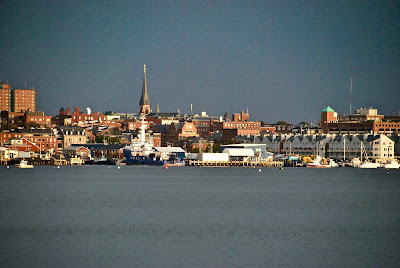 |
| Babb's "Copley Plunge" Boston Museum of Fine Art |
When I contacted Seth Lipsky, a summer friend from New York City who has a place in Waterford, Maine, he suggested we have an early breakfast in Bethel. He had plans to meet another friend there, then go up Mount Washington to paint. As we finished eating, in walked none other than Joel Babb of Sumner, Maine, an accomplished painter of Roman and Boston cityscapes, interior and coastal Maine scenes, as well as other subjects. I was thrilled to meet him because I’ve been admiring his work ever since the Portland Press Herald did a big spread on him exactly a year ago. I saw his exhibition at Portland’s Greenhut Gallery this summer and was sorry to miss his talk there a month ago.
 |
| Babb's “Bernd Heinrich’s Brook” 40 by 52 inches |
Seth is the founder and editor of the New York Sun, an independent conservative daily paper in New York City that published in hard copy for several years and continues to exist online. Seth has time to paint now and met Joel in that pursuit. I had told him of my recent photographic ventures which led to my interest in Babb because I had shot some of the scenes he painted in Rome and in Maine. I was doubly thrilled when both invited me to accompany them on their artistic expedition. I wasn’t dressed for a day on “the rock pile,” as locals refer to Mount Washington, but Seth said he had an extra slicker in his car so off we went. I left a voice mail for my wife as we drove.
 |
| Seth and Joel on the rock pile |
Each artist had already started two canvases — one from around the 4000-foot mark and another from 6000, both looking north toward Mount Adams. Joel often works from photographs, but these were plein air style (in the open air). They let me watch, take pictures, and ask questions as they discussed how to mix various colored paints to match the gray stone piles and dark green fir trees on the slopes, as well as the blue sky and white clouds beyond. Several tourists stopped to watch them work. The ever-gregarious Seth conversed with them, describing Joel as the master and himself as acolyte. Babb certainly is that. It’s hard to tell his work is a painting and not a photograph. It’s that good.
It was a lovely day, cold at first and a bit breezy, but the sun was strong and it soon warmed enough that I only needed a light fleece to stay comfortable. Only once before had I been on the Mount Washington Auto Road and I had vowed never to drive it again. Steep, narrow, winding roads with near-vertical drop-offs give me the willies, as they did in the west of Ireland earlier this year. Seth drove, however, and it didn’t seem to bother him. He has a season pass and goes up there a lot. I sat in the back and sometimes had to close my eyes.
 |
| The artists discuss colors |
Knowing nothing about oil painting, I was continually impressed by their strenuous efforts to render the scenes before them just as they existed. They scrutinized each facet of the view much more closely than I ever do with my camera and conditions changed by the hour as the sun moved. Joel pointed to a patch of snow on one of the canvases he had begun back in July. He wasn’t satisfied with his shades of green on the fir groves and worked to mix more colors to strive for a closer match. I felt privileged that they both answered my questions and I tried not to be a pest.
His paintings at Greenhut Galleries in July were priced in five figures, while I only charge $300 for one of my photos. He asked how my sales were going and I told him selling my stuff was a new endeavor and I only photographed only things that interest me -- and I resisted requests to do otherwise. At that he raised his white eyebrows, saying, “You turned down commissions? You know, Leonardo said once: ‘Give them a few virgins. Then paint what you want.’” Babb had studied Da Vinci extensively during his year in Rome. Like him, he attended dissections at BU Medical School to understand musculature — although Da Vinci had done the dissections himself.
 |
| Da Vinci anatomy drawing |
Seth and Joel both immersed themselves in their work. For Joel, though, it’s total immersion and has been for decades. He majored in art history at Princeton, but decided to be an artist instead of an historian. He said only two others in his class had done so. At about three in the afternoon, I helped them carry their equipment back to Seth’s minivan and we drove back down the rock pile. Again I closed my eyes at precarious points but Seth remained undaunted.
As we each walked to our vehicles at the bottom, Joel invited me to see his studio in Sumner. I intend to take him up on that sometime this fall.

































